PHOTOS: Taking you behind the scenes of the Expo Line weekend closure at Waterfront Station
PHOTOS: Taking you behind the scenes of the Expo Line weekend closure at Waterfront Station
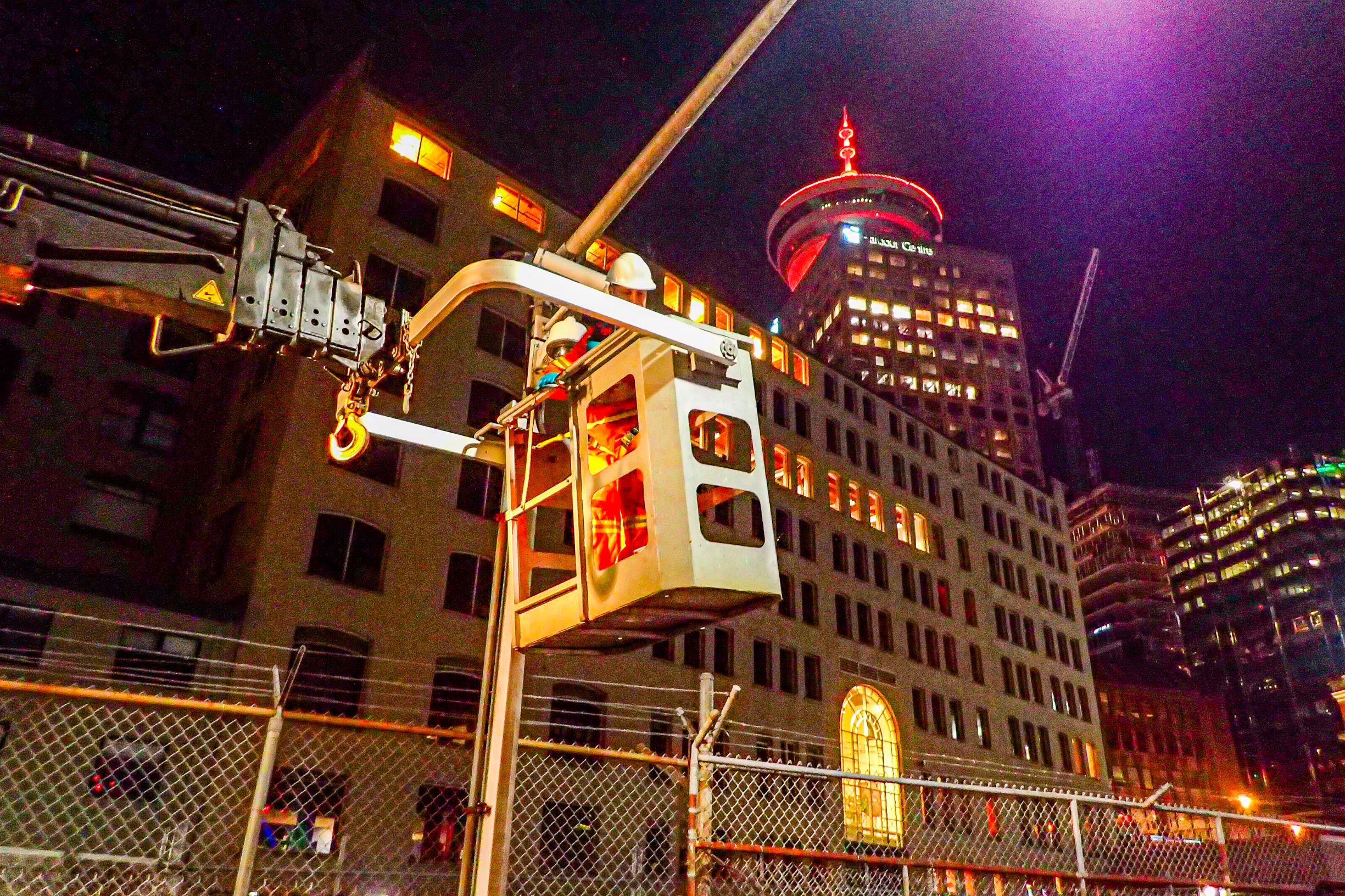
Earlier last month, the Expo Line platform at Waterfront Station was closed for a weekend to accelerate maintenance work while there are fewer people on the system. This created a continuous 51-hours of maintenance for power and system upgrades, extensive power rail cleaning and rail repairs, track intrusion alarm maintenance and cleaning, guideway maintenance, detailed platform cleaning, bird prevention installations, lighting upgrades and repairs and CCTV camera repairs.
Normally, there’s only a brief, four-hour maintenance window from around 1 a.m. to 5 a.m. in the morning. This covers the time period from between the last SkyTrain departing Waterfront Station until the first “sweep” train before the start of service. The sweep train, which doesn’t carry passengers, travels along the SkyTrain tracks to check for any debris and safety issues before the first train at 5:32 a.m. departing King George Station.
Once you factor in setup and teardown time, there’s only a couple of hours for maintenance each evening, so a project would take multiple days, and sometimes weeks or months to complete. As you can imagine, we were able to get a lot of work done in a short period of time during the closure! Here’s a behind the scenes look at some of the work that was completed.
On this weekend, Wayside Maintenance at B.C. Rapid Transit Company’s completing work on the Expo Line at Waterfront Station and its adjacent tracks. The guideway (tracks), plant (facilities maintenance), electronics and power departments make up Wayside Maintenance. They are responsible for maintaining 80 kilometres of track and stations on the Expo and Millennium Lines, as well as two Operations and Maintenance Centres in Burnaby and another in Coquitlam.
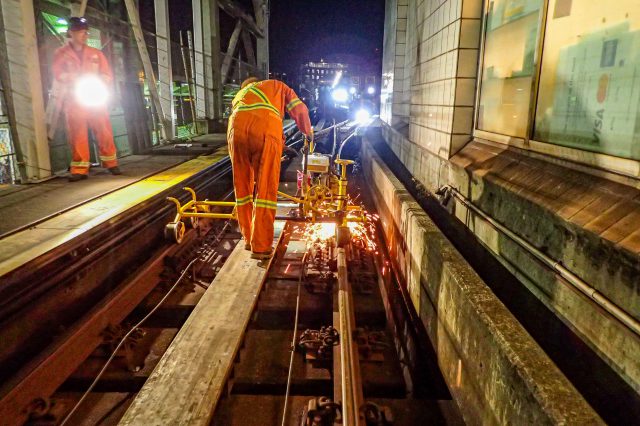
A guideway technician uses a rail grinder to smooth out the tracks at Waterfront Station’s Platform 1. Rail grinders can range from a large self-propelled rotary grinder down to a handheld angle grinder.
Rail grinding is standard maintenance work that we do on a regular basis on the SkyTrain network to smooth out the tracks, which improves ride quality, reduces noise levels and extends the rail’s life. Over time, the surface of SkyTrain rail can become corrugated with the repeated passing of train wheels.
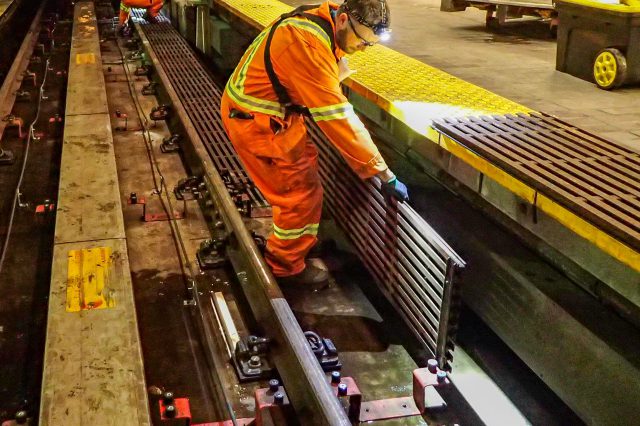
A guideway serviceperson re-installs the Platform Intrusion Emergency System (PIES) — or track intrusion alarm system — sensor plates after they were removed to install new brackets for the Automatic Train Control (ATC) cable. The ATC cable allows for the trains to run automatically and provides a way for the SkyTrain Control Centre to communicate with the trains. The cable needs to be set up correctly so the antennas on the trains receive a good signal.
While the sensor plates were removed, staff were also able to retrieve small objects that had fallen through these plates such as wireless earphones and jewelry for a hopeful reunification with customers. Technicians also replaced and cleaned various parts of the track intrusion alarm system to ensure the correct operation. A final test is done by an electronics technician before the system is put back into operation.
Never enter the tracks to retrieve a dropped item. Instead, pickup the red emergency phone on the platform to get in touch with the SkyTrain Control Centre or alert a SkyTrain Attendant. Even if there’s no train or it has emergency stopped, the tracks remain charged with 600 volts of power and the risk of electrocution is present.
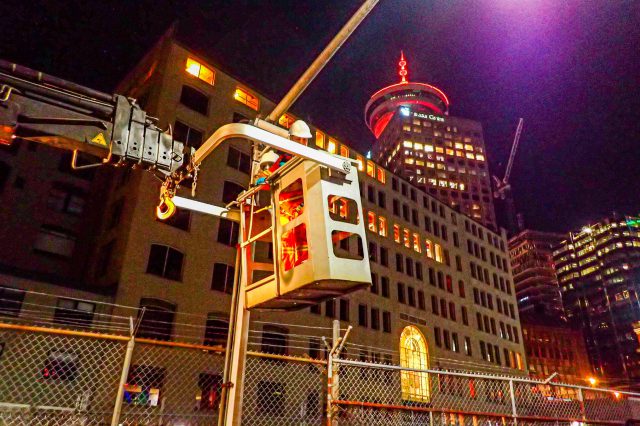
An electronic technician inspects a camera in the “tail tracks” at Waterfront Station. The tail tracks are the tracks that extend past the station where we stage trains for rush hour service, store maintenance equipment during the daytime, and where Waterfront-bound trains turnaround to become a train towards Production Way–University or King George.
There are many cameras along the SkyTrain network and sometimes the technicians need to be lifted up with the use of a crane and bucket to complete their inspections and maintenance.
As part of our SkyTrain Customer Communications Upgrades, we’re installing new and additional station CCTV (Closed Circuit Television) cameras new CCTV cameras at the stations to improve safety.
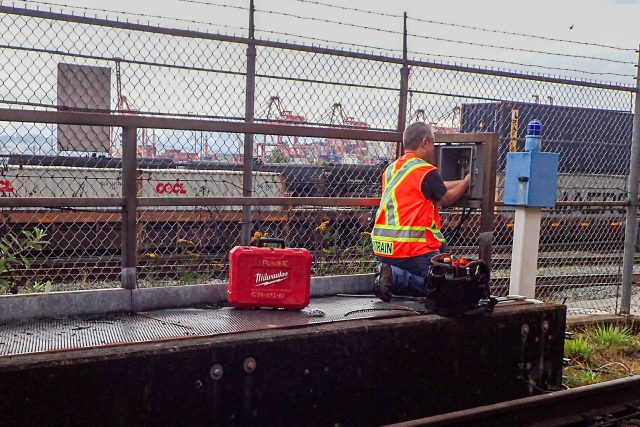
A power technician performs repairs on the “blue light” in the tail track. The blue light is a safety system, used by employees, that indicates propulsion power status.
A guideway technician removes an old track switch machine with the help of a crane. The machine controls the track switches that allow trains to move from one track to another.
These machines are replaced periodically, depending on the amount of use, and in the case of the Expo Line at Waterfront Station, it’s one of the most used locations along the SkyTrain network. Most trains coming into the station, use the track switch to change directions to head back to Production Way–University or King George Station.
These sophisticated machines weigh about 150 kilograms and can be very difficult to lift out and lower into place. Once it’s set in place, it is re-connected to the track work and the wiring is installed by an electronic technician. It is then ready for testing with the help of the control operators in the Operations and Maintenance Centre. The machine is cycled to ensure it is working properly before the guideway technicians perform the final adjustments.
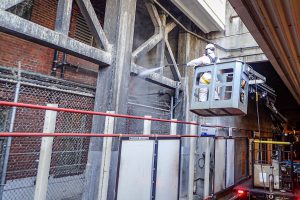
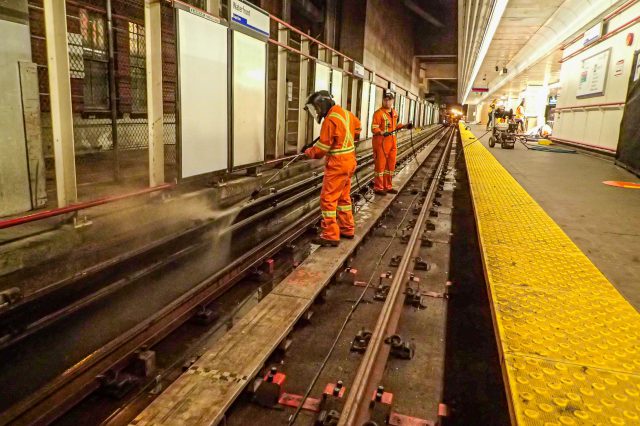
On the left, a plant serviceperson cleans droppings with a pressure washer in preparation for bird prevention installations, and on the right, a guideway serviceperson pressure washes the power rails to remove a build-up of debris. Each SkyTrain car has a “shoe” that draws power from the rails, so when the power rail has debris built up on it, it can make it harder for the shoe to draw power.


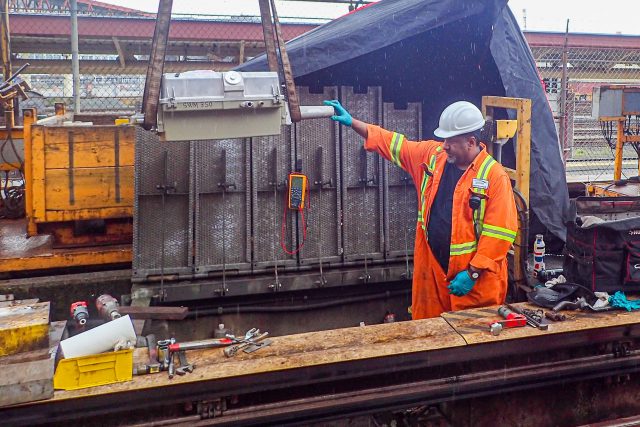




Thanks for this! It’s always interesting to get a peek behind the scenes of something that you use regularly but don’t get the chance to see in person.
Much thanks to you such a great amount for sharing such a marvelous article https://hot-maillogin.space/